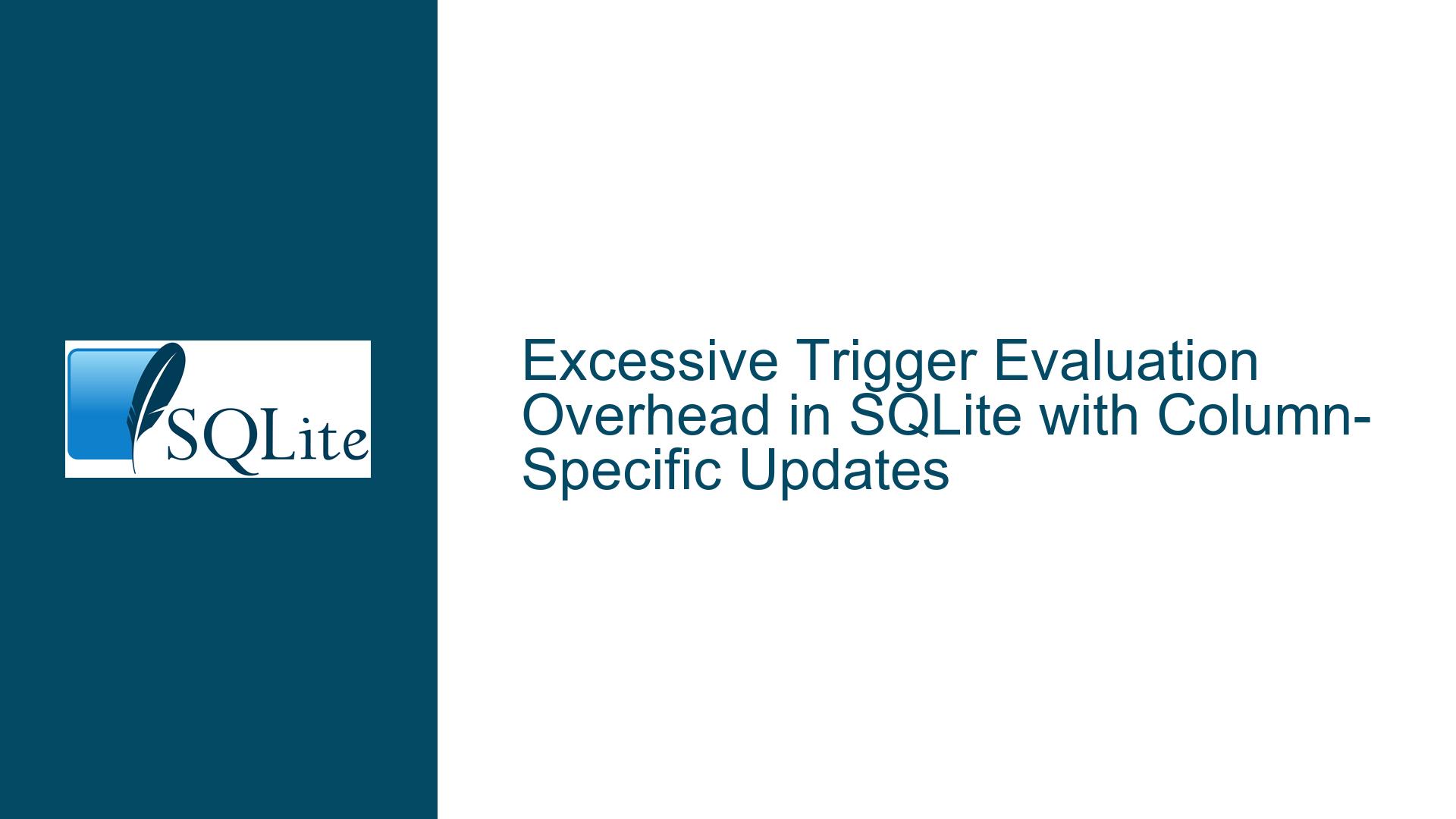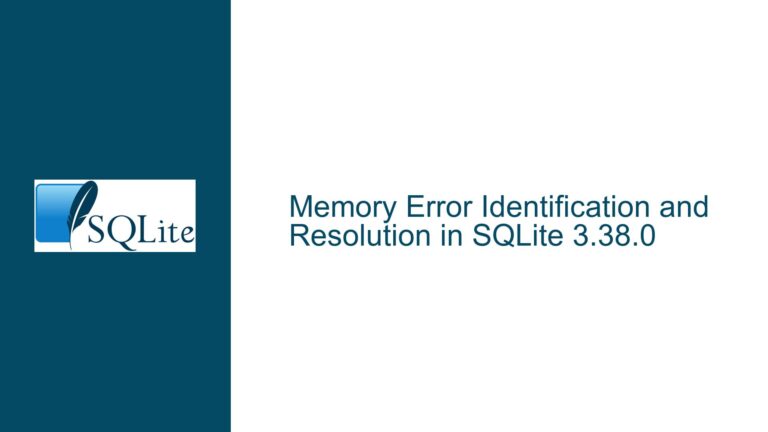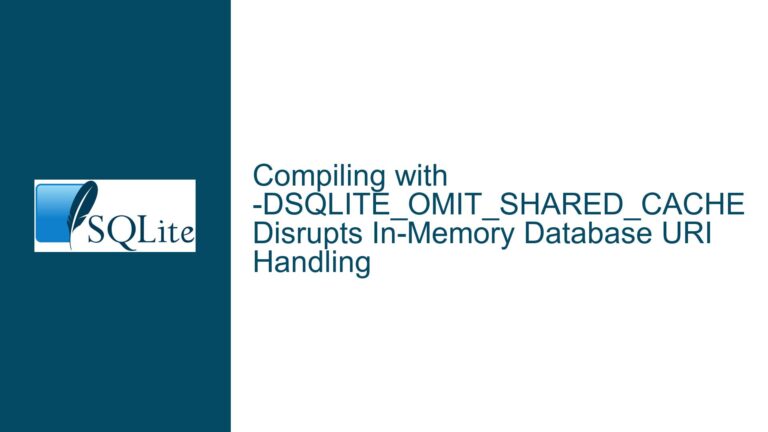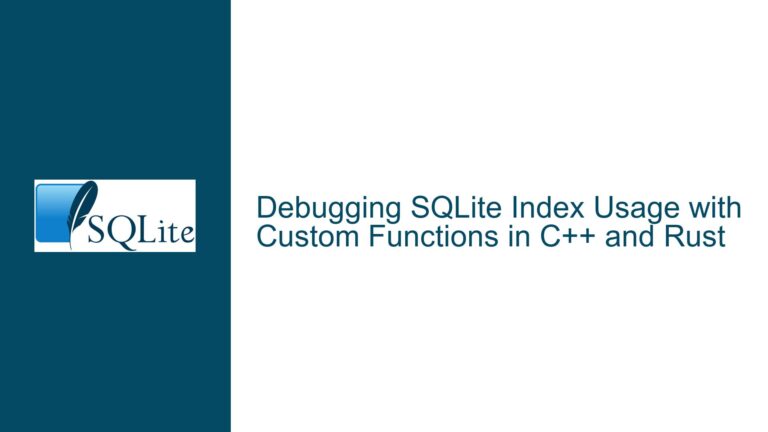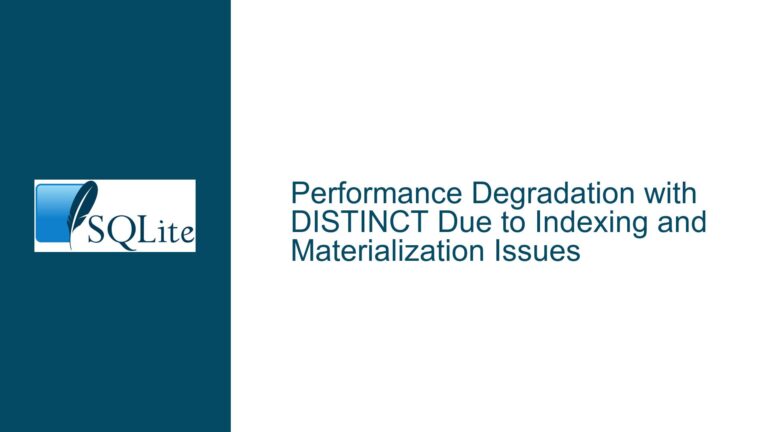Excessive Trigger Evaluation Overhead in SQLite with Column-Specific Updates
Understanding and Resolving Unnecessary Trigger Scans During Column-Specific Updates in Large SQLite Schemas
Issue Overview: SQLite Unnecessarily Prepares and Executes Triggers Linked to Unmodified Columns
The core problem arises when performing INSERT or UPDATE operations on tables with column-specific triggers (e.g., AFTER UPDATE OF c2 ON A). Despite modifying only specific columns, SQLite appears to evaluate triggers associated with other columns in the same table and cascading triggers in related tables. This behavior manifests as severe performance degradation in schemas with thousands of tables and triggers, where even simple operations trigger extensive preparation and execution cycles for unrelated triggers.
Key Observations from the Scenario:
- Schema Complexity: Over 1,000 tables with multiple triggers each create a combinatorial explosion of potential trigger evaluations.
- Column-Specific Trigger Definitions: Triggers are defined to activate only when specific columns are updated (e.g.,
AFTER UPDATE OF c2 ON A). - Cascading Trigger Chains: Updates on Table A fire triggers that modify Tables B/C, which in turn activate their own triggers.
- Unexpected Preparation Overhead: SQLite prepares triggers even when their associated columns are not modified, as reported in the user’s performance analysis.
Underlying SQLite Trigger Mechanics:
- Trigger Preparation Phase: During query compilation, SQLite identifies all triggers whose
ONtable andOFcolumns match the target table and modified columns. These triggers are added to the execution plan. - Trigger Execution Phase: At runtime, SQLite evaluates
WHENconditions (if present) and executes triggers that pass these checks. - Nested Trigger Activation: Any data modifications caused by a trigger (e.g., inserting into Table B) recursively invoke the same preparation/execution logic for triggers on the affected tables.
Possible Causes: Why Unmodified Column Triggers Are Being Processed
1. Misconfigured Trigger Definitions
Triggers defined without explicit OF clauses or with overly broad WHEN conditions may activate for unintended column updates. Example: A trigger intended to activate only for c2 updates might lack an OF c2 clause, causing it to activate for any column change.
2. Implicit Trigger Activation via Cascading Operations
Even if a trigger on Table A is correctly scoped to c2, modifying c2 might cause it to update Table B. If Table B has triggers that don’t filter on specific columns, these will activate unconditionally, creating secondary evaluation overhead.
3. Overlap in Column Update Sets
An UPDATE statement modifying multiple columns (e.g., SET c2=1, c3=2) will activate all triggers associated with any of the modified columns. If the user intended to activate only one trigger per column, this behavior leads to redundant processing.
4. SQLite’s Trigger Preparation Guarantees
SQLite must prepare all triggers that could fire based on the initial UPDATE statement’s syntax. For example:
UPDATE A SET c2 = 5; -- Activates triggers with "OF c2"
Triggers with OF c2 are prepared regardless of whether c2’s value actually changes (e.g., if c2 was already 5). The WHEN clause is evaluated at runtime, but the trigger’s code must still be prepared upfront.
5. Index and Data Model Inefficiencies
If triggers perform unindexed lookups in their WHEN clauses or modify tables without proper indexes, execution time balloons—especially when thousands of triggers fire in sequence.
Troubleshooting Steps, Solutions & Fixes: Optimizing Trigger Performance in High-Volume Schemas
Step 1: Audit Trigger Definitions for Precision and Scope
Action: Generate a full list of triggers and their activation conditions using:
SELECT sql FROM sqlite_schema WHERE type = 'trigger';
Analysis:
- Verify that every column-specific trigger includes an
OFclause listing exactly the columns it should monitor. Example of a well-scoped trigger:CREATE TRIGGER t1 AFTER UPDATE OF c2 ON A WHEN NEW.c2 != OLD.c2 BEGIN INSERT INTO B(...) VALUES (...); END; - Identify triggers missing
OFclauses that activate on any column update:CREATE TRIGGER t2 AFTER UPDATE ON A -- No OF clause; activates for any column WHEN NEW.c2 != OLD.c2 BEGIN ... END;Rewrite these to include
OFclauses where appropriate.
Step 2: Consolidate Triggers with Overlapping Logic
Problem: Multiple triggers on the same table/column combination create redundant preparation work.
Solution: Merge triggers using WHEN conditions to handle multiple cases. Example:
Before:
CREATE TRIGGER t1 AFTER UPDATE OF c2 ON A ...;
CREATE TRIGGER t2 AFTER UPDATE OF c3 ON A ...;
After:
CREATE TRIGGER t_merged AFTER UPDATE OF c2, c3 ON A
WHEN (NEW.c2 != OLD.c2) OR (NEW.c3 != OLD.c3)
BEGIN
-- Use CASE statements to handle c2 vs. c3 cases
SELECT CASE
WHEN NEW.c2 != OLD.c2 THEN
INSERT INTO B(...) VALUES (...);
WHEN NEW.c3 != OLD.c3 THEN
INSERT INTO C(...) VALUES (...);
END;
END;
Benefit: Reduces the number of triggers SQLite must prepare during updates involving multiple columns.
Step 3: Implement Runtime Short-Circuiting with WHEN Clauses
Principle: Add stringent WHEN conditions to prevent trigger execution unless absolutely necessary.
Example:
CREATE TRIGGER t1 AFTER UPDATE OF c2 ON A
WHEN NEW.c2 IS NOT OLD.c2 -- Skip if value hasn’t changed
BEGIN
...
END;
Advanced Technique: For triggers that modify secondary tables, add existence checks to avoid unnecessary operations:
CREATE TRIGGER t1 AFTER UPDATE OF c2 ON A
WHEN NEW.c2 != OLD.c2 AND EXISTS (SELECT 1 FROM B WHERE key = NEW.key)
BEGIN
UPDATE B SET ... WHERE key = NEW.key; -- Skip if no matching row in B
END;
Step 4: Analyze and Optimize Trigger-Induced Cascades
Diagnostic Query:
-- Find triggers that modify other tables
SELECT name, sql
FROM sqlite_schema
WHERE type = 'trigger'
AND sql LIKE '%INSERT INTO%'
OR sql LIKE '%UPDATE%';
Mitigation Strategies:
- Defer Non-Critical Operations: Use
AFTER UPDATEtriggers instead ofBEFORE UPDATEto allow batch processing of changes. - Disable Triggers During Bulk Operations:
PRAGMA defer_foreign_keys = ON; -- Delay FK checks PRAGMA recursive_triggers = OFF; -- Prevent cascading triggers -- Perform bulk updates PRAGMA defer_foreign_keys = OFF; PRAGMA recursive_triggers = ON; - Batch Updates: Instead of single-row
UPDATEstatements, use batchedUPDATE ... FROMCTEs to minimize trigger activations per transaction.
Step 5: Leverage Indexes to Accelerate WHEN Clause Evaluations
Scenario: A trigger’s WHEN clause performs a subquery or join that lacks indexes.
Example:
CREATE TRIGGER t1 AFTER UPDATE OF c2 ON A
WHEN (SELECT COUNT(*) FROM B WHERE B.a_id = NEW.id) > 0
BEGIN
...
END;
Optimization: Add an index on B(a_id) to speed up the correlated subquery.
Step 6: Upgrade SQLite and Validate Execution Plans
SQLite Version Considerations: Versions before 3.39.4 had suboptimal trigger preparation logic. Upgrade to the latest version and test with:
sqlite3 --version # Confirm ≥3.42.0
Execution Plan Analysis: Use EXPLAIN to see which triggers are prepared:
EXPLAIN UPDATE A SET c2 = 5 WHERE id = 1;
Look for opcodes like Program or Trigger that indicate trigger preparation.
Step 7: Schema Normalization and Partitioning
Radical Restructuring: For schemas with 1,000+ tables, consider:
- Table Partitioning: Merge tables with identical structures into partitioned tables using
CHECKconstraints. - Trigger Abstraction: Replace per-table triggers with a centralized logic using dynamic SQL generation (via application code).
- Sharding: Distribute tables across multiple databases if cross-table triggers aren’t required.
Step 8: Benchmark and Profile Trigger Overhead
Tooling:
- Use SQLite’s
sqlite3_profile()API to measure time spent in trigger preparation/execution. - Enable logging with
sqlite3_trace_v2()to capture trigger activation sequences.
Example Workflow:
- Isolate a test case with 2-3 representative tables/triggers.
- Measure baseline performance without triggers.
- Gradually reintroduce triggers while profiling execution times.
- Identify "hot" triggers contributing disproportionate overhead.
Final Recommendation: Strategic Trigger Elimination
For legacy systems where full schema redesign isn’t feasible, conduct a cost-benefit analysis:
- Disable Low-Value Triggers: Comment out triggers that provide non-critical functionality.
- Replace Triggers with Application Logic: Handle non-performance-critical operations in application code.
- Use Shadow Tables: Maintain denormalized copies of data updated asynchronously via queues instead of real-time triggers.
By methodically auditing trigger logic, consolidating redundant operations, and leveraging SQLite’s configuration options, developers can mitigate the "trigger scan tax" in large-scale schemas. The goal is to transform a tangled web of interlinked triggers into a streamlined pipeline where only essential logic activates during data modifications.
